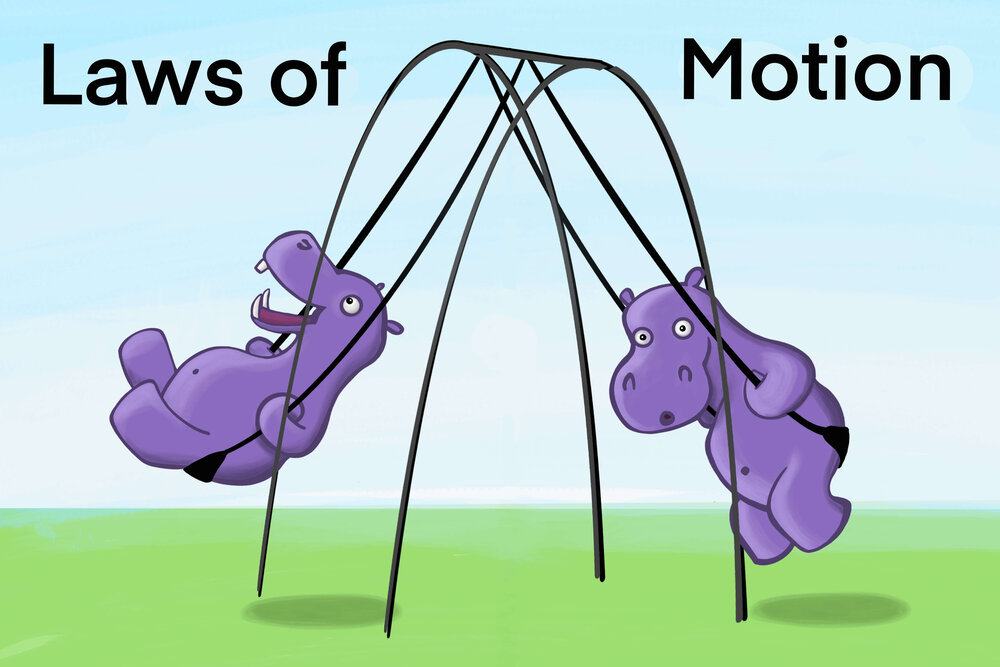Study Guide: Laws of Motion

Isaac Newton
In science, “laws” are observations about the physical universe that seem to be true for all things in all places. They are believed to be som of our bst explanations for what really is reality. In the 1600s in England, Sir Isaac Newton discovered several of these laws, the laws for gravity, motion, the motion of the planets, light, and color. He discovered so many things and could show so clearly how they worked using experiments and m
The Laws of Motion
First Law: Inertia
An object that is sitting at rest will stay at rest, and an object that is in motion will stay in motion until a force acts upon it.
This is why astronauts can let go of a tool in space and it will stay in one spot until they grab it. If the astronaut throws an object, it will travel in a straight line and never stop. In space, an object will stay in one place or keep on moving in the same direction and with the same speed forever because there is no gravity or air in space to act on the tool, unlike on earth, where without sustained force, the friction of atmosphere will slow and eventually stop an object in motion.
A marathon runner is unable to stop running immediately after he has crossed the finish line. He has to take few more strides past the finish line, otherwise he will fall over. This is due to the inertia of motion, or Newton’s first rule of motion, which prevents the body from abruptly stopping and forces it to maintain its state of motion.
When a car speeds up abruptly, the passengers feel a jerk that pulls them backwards. This is due to the fact that the car begins to move while the body remains at rest, resulting in a sudden movement, which is an abrupt and brief shift in state.
Second Laws: Force
The greater the force the greater the acceleration. The greater the mass, the greater the force needed to move the object. Two objects with different weights (mass) will need different forces to move them and the acceleration levels will be different.
The formula used for Newton’s Second Law is $F = ma$. This is Force = mass times acceleration. Y
To find the acceleration, change the formula to: $a = F \div m$
To find the mass, change the formula to: $m = F \div a$
A ball when struck develops a certain degree of acceleration. The force given to the ball has a direct relationship with the ball’s acceleration. This means that the harder you strike the ball, the faster it moves.
The impact force is the force that occurs between an obstruction and the car during an accident. The magnitude of the impact force is determined by the mass of the items colliding and the speed at which they are moving. This means that the bigger the mass of the items colliding, the greater the intensity of the impact force. Similarly, the faster the speed at which the car goes, the bigger the magnitude of the impact force.
Third Law: For every action there is an equal and opposite reaction.
Forces are always found in pairs. If the forces are equal in opposite directions, the object will not move. The forces cancel each other out so that the acceleration is zero.
If one force acting in one direction is greater than the force acting in the opposite direction, the object will move.
For example, if you are pulling on a rope tied to la oad of bricks and the bricks start to move, the force you are using is more than the bricks are using to stay in one place.
Rockets sent into space use Newton’s Three Laws of Motion. When a rocket fires, th explosion of fuel generates a force that pushes the rocket upward against the fore of the Earth’s gravity. As long as the forward force forward is greater than the backward force the rocket rises.
Birds and planes fly by exerting force on the air in the opposite direction of the force they want to move in. A bird’s wings, for example, pull air downward and backward to gain lift and propel it ahead.
Questions
- What is Newton’s First Law of Motion?
- What is Newton’s Second Law of Motion?
- What is Newton’s Third Law of Motion?
- When in space, why does an astronaut’s hammer stay in one spot when he drops it?
- When a rocket’s engines ignite, what two forces are in action?
Answers
- Newton’s First Law of Motion: An object at rest will stay at rest and an object in motion will stay in motion, unless a force acts on it.
- Newton’s Second Law of Motion: Force equals mass times acceleration ($F = ma$).
- Newton’s Third Law of Motion: For every action, there is an equal and opposite reaction.
- An astronaut’s hammer will stay in one spot because gravity and friction with molecules in the air are not acting on it.
- When a rocket’s engines ignite, one force pushes it upward into the atmosphere and and equal force pushes the burned fuel from the exhaust downward.


